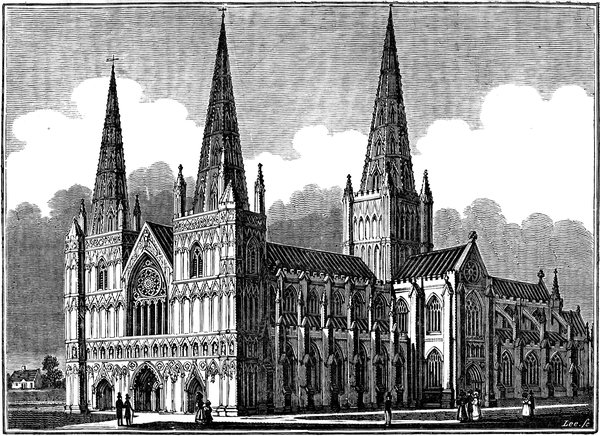The Saturday Magazine.

UNDER THE DIRECTION OF THE COMMITTEE OF GENERAL LITERATURE AND EDUCATION, APPOINTED BY THE SOCIETY FOR PROMOTING CHRISTIAN KNOWLEDGE.

LICHFIELD CATHEDRAL.
Vol. III.
LICHFIELD CATHEDRAL.
The first authentic mention of Lichfield occurs inBede’s Ecclesiastical History, where it is alluded toas the See of an Anglo-Saxon Bishop. The name isof Saxon origin, but its etymology has been muchdisputed. In the Saxon Chronicle the word iswritten Licetfeld; in Bede, Lyccetfelth and Licitfeld.Some etymologists derive its signification from leccian,to water (and it is well known to have abounded innumerous lakes and pools); others, from the verblicean or lician, to like, or to be agreeable, andtherefore make it to signify Pleasant Field. It hashowever been more frequently allowed to be derivedfrom lic, a dead body, and consequently as signifyingcadaverum campus, the Field of Dead Bodies. This derivationis supported by a prevailing tradition, of themartyrdom of a thousand British Christians on thisspot, at the time of the persecution (A. D. 303) underDioclesian, when Maximian was governor of Britain.
It is certain that the present diocese of Lichfieldand Coventry, anciently formed a part of thekingdom of Mercia, which, being conquered by (theChristian King) Oswy, introduced the Christian faithinto this powerful kingdom of the Saxon Heptarchy.He made Lichfield an episcopal See, by appointingDiuma, a Scotsman, the first Bishop, A. D. 656.After a succession of three others, the famousCeadda, or Chad, was raised to the Bishopric A. D. 667.Bede informs us, that “he had built himself anhabitation not far removed from the church; whereinhe was wont to pray, and read with a few, that is,seven or eight, of the brethren, as often as he had anyspare time from the labour and ministry of the word.”
From this period, little is known of the history ofthe See till after the Norman Conquest, when at theNational Council held in London, A. D. 1075, it wasdetermined to remove the See of Lichfield to Chester,which was done by Peter (the first bishop appointedby William the Conqueror), who went by the appellationof Bishop of Chester and Lichfield. Robert deLymesey was his successor, and removed the See toCoventry, having obtained from the King, the custodyof that Abbey (originally founded by Canute); thisedifice having been restored and greatly enriched byLeofric, Earl of Hereford, and his celebrated wifeLady Godiva. Robert Peeke, chaplain to Henry theFirst, was consecrated to this See, A. D. 1117, andwas succeeded, 1128,